 W
WThe earliest known written records of the history of China date from as early as 1250 BC, from the Shang dynasty, during the king Wu Ding's reign, who was mentioned as the twenty-first Shang king by the same. Ancient historical texts such as the Book of Documents, the Records of the Grand Historian and the Bamboo Annals mention and describe a Xia dynasty before the Shang, but no writing is known from the period, and Shang writings do not indicate the existence of the Xia. The Shang ruled in the Yellow River valley, which is commonly held to be the cradle of Chinese civilization. However, Neolithic civilizations originated at various cultural centers along both the Yellow River and Yangtze River. These Yellow River and Yangtze civilizations arose millennia before the Shang. With thousands of years of continuous history, China is one of the world's oldest civilizations, and is regarded as one of the cradles of civilization.
 W
WBenevolence and the Mandate of Heaven: Transformation of pre-Qin Confucian Classics is a book by a Taiwanese historian Olga Gorodetskaya, published in 2010 in Taipei. The book concerns itself with the Confucian philosophical concepts of Benevolence (Ren) and the Mandate of Heaven and their evolution during the period before the establishment of the empire by Qin dynasty.
 W
WBritish Weihaiwei, on the northeastern coast of China, was a leased territory of the United Kingdom from 1898 until 1930. The capital was Port Edward. The leased territory covered 288 square miles (750 km2) and included the walled city of Port Edward, bay of Wei-hai-wei, Liu-kung Island and a mainland area of 72 miles (116 km) of coastline running to a depth of 10 miles (16 km) inland. Together with Lüshunkou it controlled the entrance to the Gulf of Zhili and, thus, the seaward approaches to Beijing.
 W
WCathay is an alternative European historical name for China. During the early modern period, Europeans thought of Cathay as a completely separate and distinct culture from China. As knowledge of East Asia increased, Cathay came to be seen as the same polity as China. The term "Cathay" became a poetic name for China.
 W
WYujiulü Cheluhui was ruler and tribal chief of the Rourans, succeeded Mùgǔlǘ (Mugului) and was the son of the same, his year of birth is unknown. He was a rough man and his government was marked by nomadism and peace.
 W
WThe China Biographical Database (CBDB) is a relational database on Chinese historical figures from the 7th to 19th centuries. The database provides biographical information of approximately 360,000 individuals up till April 2015.
 W
WOver the last four thousand years, Chinese imperialism has been a central feature of the history of East Asia. Since the recovery of Chinese strength in the late 20th century, the issues involved have been of concern to China's neighbors to the east.
 W
WChinese jade refers to the jade mined or carved in China from the Neolithic onward. It is the primary hardstone of Chinese sculpture. Although deep and bright green jadeite is better known in Europe, for most of China's history, jade has come in a variety of colors and white "mutton-fat" nephrite was the most highly praised and prized. Native sources in Henan and along the Yangtze were exploited since prehistoric times and have largely been exhausted; most Chinese jade today is extracted from the northwestern province of Xinjiang.
 W
WChinese philosophy originates in the Spring and Autumn period (春秋) and Warring States period (戰國時期), during a period known as the "Hundred Schools of Thought", which was characterized by significant intellectual and cultural developments. Although much of Chinese philosophy begun in the Warring States period, elements of Chinese philosophy have existed for several thousand years. Some can be found in the I Ching, an ancient compendium of divination, which dates back to at least 672 BCE. It was during the Warring States era that what Sima Tan termed the major philosophical schools of China—Confucianism, Legalism, and Taoism—arose, along with philosophies that later fell into obscurity, like Agriculturalism, Mohism, Chinese Naturalism, and the Logicians. Even in modern society, Confucianism is still the creed of etiquette for Chinese society.
 W
WCorvée is a form of unpaid, unfree labour, which is intermittent in nature and which lasts limited periods of time: typically only a certain number of days' work each year.
 W
WThe Discourse of Lama《喇嘛说》is an article written by the Qianlong Emperor in the 57th year of the Qianlong era of the Qing dynasty (1792) to elaborate on the policy of using lot-drawing process with Golden Urn to pick reincarnated lamas including the Dalai Lama and Panchen Lama. The article was engraved on the stone tablet in the Lama Temple in Beijing. The height of the stone tablet is 598 cm.
 W
WDynasties in Chinese history, or Chinese dynasties, were hereditary monarchical regimes that ruled over China during much of its history. From the inauguration of dynastic rule by Yu the Great in circa 2070 BC to the abdication of the Xuantong Emperor on 12 February 1912 in the wake of the Xinhai Revolution, China was ruled by a series of successive dynasties. Dynasties of China were not limited to those established by ethnic Han—the dominant Chinese ethnic group—and its predecessor, the Huaxia tribal confederation, but also included those founded by non-Han peoples.
 W
WWaves of Chinese emigration have happened throughout history. The mass emigration, which occurred from the 19th century to 1949, was mainly caused by wars and starvation in mainland China, economic issues abroad such as the California gold rush in 1849, as well as problems resulting from political corruption. Most emigrants were illiterate peasants and manual labourers, who emigrated to work in places such as the Americas, Australia, South Africa, Southeast Asia, and Zealandia.
 W
WFeng Shan or feng-shan, also referred to as the Feng and Shan sacrifices, was an official rite offered by the Son of Heaven to pay homage to heaven and earth. The sacrifices were usually offered at Mount Tai, the highest peak in the area, and nearby Mount Liangfu. The emperor would pay homage to heaven and earth in the Feng and Shan sacrifices respectively. Completing Feng Shan allowed the emperor to receive the mandate of heaven. The term feng can roughly be translated to mean "to seal", while the term shang can roughly be translated to mean "to clear away".
 W
WThe Fengtian clique was one of several opposing military factions that constituted the early Republic of China during its Warlord Era. It was named after Fengtian Province, and operated from a territorial base comprising the three northeastern provinces that made up Manchuria. Warlord Zhang Zuolin, known as the "Old Marshal," led the clique with support from Japan.
 W
WIn Confucian, Chinese Buddhist and Taoist ethics, filial piety is a virtue of respect for one's parents, elders, and ancestors. The Confucian Classic of Filial Piety, thought to be written around the Qin-Han period, has historically been the authoritative source on the Confucian tenet of filial piety. The book, a purported dialogue between Confucius and his student Tseng Tzu, is about how to set up a good society using the principle of filial piety. Filial piety is central to Confucian role ethics.
 W
WThe Guiyi Circuit, also known as the Guiyi Army, was a regional regime nominally subordinate to the Chinese Tang dynasty and later on the Northern Song dynasty. The Guiyi Circuit was controlled by the Zhang family from the second half of the 8th century to the 10th century and then the Cao family until the 11th century. The Guiyi Circuit was headquartered in Shazhou (沙州).
 W
WThe Hephthalites, sometimes called the White Huns, were a people who lived in Central Asia during the 5th to 8th centuries. They existed as an Empire, the Imperial Hephthalites, and were militarily important from 450 CE, when they defeated the Kidarites, to 560 CE, date of their defeat to combined First Turkic Khaganate and Sasanian Empire forces. After 560 CE, they formed "principalities" in the area of Tokharistan, under the suzerainty of the Western Turks and the Sasanian Empire, before being taken over by the Tokhara Yabghus in 625 CE.
 W
WDance in China has a long recorded history. Depictions of dancing in China appeared over 4,000 years ago. The early dances may be folk dances or ritual dances, some of which developed into court dances. The most important of the early dances served important ritual and ceremonial roles and are known as yayue which continued to be performed at the imperial court until the Qing dynasty. A profusion of dances in popular and court entertainment as well as folk dances have been recorded in ancient texts. The art of dance in China reached a peak during the Tang dynasty when numerous dances were recorded. Dancing as an individual art form declined in the later eras when dances become incorporated into operas and female dancing also declined when footbinding became more prevalent. In more recent times dance has enjoyed a resurgence, and it is widely performed by the public and professionals alike.
 W
WThe history of Kashmir is intertwined with the history of the broader Indian subcontinent and the surrounding regions, comprising the areas of Central Asia, South Asia and East Asia. Historically, Kashmir referred to the Kashmir Valley. Today, it denotes a larger area that includes the Indian-administered union territories of Jammu and Kashmir and Ladakh, the Pakistan-administered territories of Azad Kashmir and Gilgit-Baltistan, and the Chinese-administered regions of Aksai Chin and the Trans-Karakoram Tract.
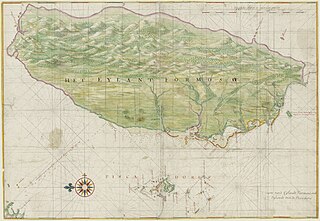 W
WAs a result of the surrender of Japan at the end of World War II, the island of Taiwan was placed under the governance of the Republic of China (ROC), ruled by the Kuomintang (KMT), on 25 October 1945. Following the February 28 massacre in 1947, martial law was declared in 1949 by the Governor of Taiwan Province, Chen Cheng, and the ROC Ministry of National Defense. Following the end of the Chinese Civil War in 1949, the ROC government retreated from the mainland as the Communists proclaimed the establishment of the People's Republic of China. The KMT retreated to Taiwan and declared Taipei the temporary capital of the ROC. For many years, the ROC and PRC each continued to claim in the diplomatic arena to be the sole legitimate government of "China". In 1971, the United Nations expelled the ROC and replaced it with the PRC.
 W
WThe History of the Republic of China begins after the Qing dynasty in 1912, when the formation of the Republic of China as a constitutional republic put an end to 2,000 years of imperial rule. The Manchu-led Qing dynasty ruled China proper from 1644 to 1912. The Republic experienced many trials and tribulations after its founding which included being dominated by elements as disparate as warlord generals and foreign powers.
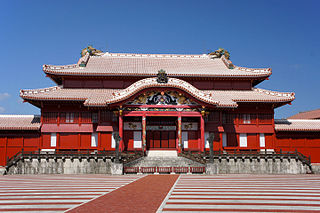 W
WThis article is about the history of the Ryukyu Islands southwest of the main islands of Japan.
 W
WHuishan clay figurines are a folk craft of Wuxi, Jiangsu Province, China, originating in the Ming Dynasty roughly 400 years ago.
 W
WThe earliest known written records of the history of China date from as early as 1250 BC, from the Shang dynasty, during the king Wu Ding's reign, who was mentioned as the twenty-first Shang king by the same. Ancient historical texts such as the Book of Documents, the Records of the Grand Historian and the Bamboo Annals mention and describe a Xia dynasty before the Shang, but no writing is known from the period, and Shang writings do not indicate the existence of the Xia. The Shang ruled in the Yellow River valley, which is commonly held to be the cradle of Chinese civilization. However, Neolithic civilizations originated at various cultural centers along both the Yellow River and Yangtze River. These Yellow River and Yangtze civilizations arose millennia before the Shang. With thousands of years of continuous history, China is one of the world's oldest civilizations, and is regarded as one of the cradles of civilization.
 W
WThe Inner Mongolian People's Republic was a state in Inner Mongolia founded shortly after the Second World War. It existed from September 9, 1945 until November 6, 1945.
 W
WA jia is a ritual vessel type found in both pottery and bronze forms; it was used to hold libations of wine for the veneration of ancestors. It was made either with four legs or in the form of a tripod and included two pillar-like protrusions on the rim that were possibly used to suspend the vessel over heat. The earliest evidence of the Jia vessel type appears during the Neolithic Period. It was a prominent form during the Shang and early Western Zhou dynasties, but had disappeared by the mid-Western Zhou.
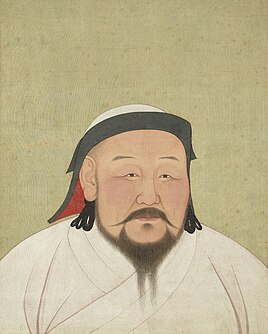 W
WKublai, also known as the Emperor Shizu of Yuan, was the fifth khagan of the Mongol Empire, reigning from 1260 to 1294. He also founded the Yuan dynasty in China as a conquest dynasty in 1271, and ruled as the first Yuan emperor until his death in 1294.
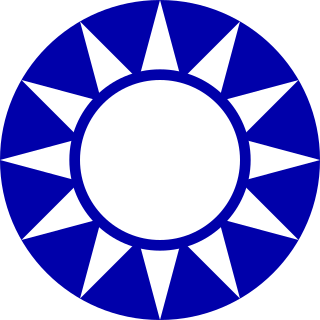 W
WThe Kuomintang (KMT), often referred to in English as the Nationalist Party of China or Chinese Nationalist Party (CNP), is a major political party in Taiwan based in Taipei. Formed in 1919, the KMT was the sole ruling party of the Republic of China from 1928 to 2000 under the Dang Guo system, and is currently an opposition political party in the Legislative Yuan. The Kuomintang is one of the two historical contemporary parties in China, the other being the Chinese Communist Party (CCP).
 W
WThe Legend of Five Goats comes from the ancient Guangzhou city, and is an origin of Guangzhou's nicknames like 'City of Five Goats', 'City of the Goat', 'City of the Rice'. It is also the origin of many Guangzhou local brands' names. The name 'Five Goats' can earliest be seen in poetry of Tang dynasty, and the related legendry can be dated back to Jin dynasty. Though the legendary had several versions, it was unified after Ming dynasty. Usually the Legend of Five Goats reflects the history that Lingnan people was colonized by Zhongyuan ancestors. In 2007, this legend was collected into the first batch of The Masterpieces of the Oral and Intangible Heritage of Humanity of Guangzhou.
 W
WLingchi, translated variously as the slow process, the lingering death, or slow slicing, and also known as death by a thousand cuts, was a form of torture and execution used in China from roughly 900 until it was banned in 1905. It was also used in Vietnam. In this form of execution, a knife was used to methodically remove portions of the body over an extended period of time, eventually resulting in death.
 W
WA Major Historical and Cultural Site Protected at the National Level, often abbreviated as guobao, is one of 5,058 monuments listed as of significant historical, artistic or scientific value by the State Administration of Cultural Heritage, which is the cultural relics administrative department of the State Council of China. Selected among Sites Protected at lower levels, Sites Protected at the National Level are lawfully the monuments with protection of the highest level in China. It is prohibited to demolish them. An approval by the State Administration of Cultural Heritage is required before a potential removal of such sites.
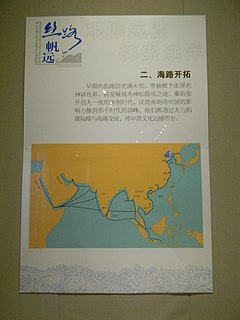 W
WThe Maritime Silk Road or Maritime Silk Route refers to the maritime section of the historic Silk Road that connected China, Southeast Asia, the Indian subcontinent, Arabian peninsula, Somalia, Egypt and Europe. It flourished between the 2nd century BC and 15th century AD. Despite its association with China in recent centuries, the Maritime Silk Road was primarily established and operated by Austronesian sailors in Southeast Asia, Tamil merchants in India and Southeast Asia, Greco-Roman merchants in East Africa, India, Ceylon and Indochina, and by Persian and Arab traders in the Arabian Sea and beyond.
 W
WChina was a monarchy from prehistoric times up to 1912 CE, when the Xinhai Revolution overthrew the Qing dynasty in favor of the Republic of China. The succession of mythological monarchs of China were non-hereditary. Dynastic rule began in circa 2070 BCE when Yu the Great and his son Qi established the Xia dynasty, and lasted until 1912 CE when dynastic rule collapsed together with the monarchical system.
 W
WYujiulü Mugulü, or Mugului, was a Xianbei slave and the ancestor the Yujiulü clan, from whom sprang the founders of the Rouran Khaganate.
 W
WThe names of China include the many contemporary and historical appellations given in various languages for the East Asian country known as Zhōngguó in its official language. China, the name in English for the country, was derived from Portuguese in the 16th century, and became popular in the mid 19th century. It is believed to be a borrowing from Middle Persian, and some have traced it further back to Sanskrit. It is also thought that the ultimate source of the name China is the Chinese word "Qin", the name of the dynasty that unified China but also existed as a state for many centuries prior. There are, however, other alternative suggestions for the origin of the word.
 W
WThe National Pacification Army (NPA), also known as the Anguojun or Ankuochun, was a warlord coalition led by Fengtian clique General Zhang Zuolin, and the military arm of the Beiyang government of the Republic of China.
 W
WThe Old Turkic script was the alphabet used by the Göktürks and other early Turkic khanates from the 8th to 10th centuries to record the Old Turkic language.
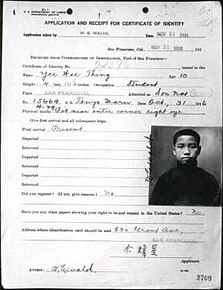 W
WPaper sons or paper daughters is a term used to refer to Chinese people who were born in China and illegally immigrated to the United States by purchasing fraudulent documentation which stated that they were blood relatives to Chinese Americans who had already received U.S. citizenship. Typically it would be relation by being a son or a daughter. Many fled China because of war and poverty. Several historical events such as the Chinese Exclusion Act and San Francisco earthquake of 1906 caused the illegal documents to be produced.
 W
WPhilippines v. China, also known as the South China Sea Arbitration, was an arbitration case brought by the Republic of the Philippines against the People's Republic of China under Annex VII to the United Nations Convention on the Law of the Sea (UNCLOS) concerning certain issues in the South China Sea including the legality of China's claimed Nine-dash line.
 W
WThe political systems of Imperial China can be divided into a central political system, a local political system, and a system for the selection of officials. There were three major tendencies in the history of the Chinese political system: the escalation of centralisation, the escalation of absolute monarchy, and the standardisation of the selection of officials. Moreover, there are the ancient supervision system and the political systems created by ethnic minorities, as well as other critical political systems which may be mentioned.
 W
WThe retreat of the Republic of China to Taiwan, also known as the Kuomintang's retreat to Taiwan or "The Great Retreat" refers to the exodus of the remnants of the internationally recognized Kuomintang-ruled government of the Republic of China to the island of Taiwan (Formosa) in December 1949 toward the end of active battles in the Chinese Civil War. The Kuomintang, its officers and approximately 2 million troops took part in the retreat; in addition to many civilians and refugees, fleeing the advance of the Communist People's Liberation Army.
 W
WThe Shudao, or the Road(s) to Shu, is a system of mountain roads linking the Chinese province of Shaanxi with Sichuan (Shu), built and maintained since the 4th century BC. Technical highlights were the gallery roads, consisting of wooden planks erected on wooden or stone beams slotted into holes cut into the sides of cliffs.
 W
WPax Sinica is a historiographical term referring to periods of peace and prosperity in East Asia, Northeast Asia, Southeast Asia, and Central Asia led by China. The multiple periods of Pax Sinica, when taken together, amounted to a length of approximately two thousand years.
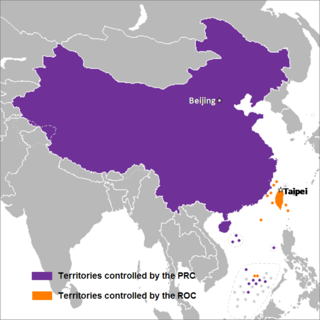 W
W"Taiwan, China", "Taiwan, Province of China", or "Taiwan Province, China" are a set of politically controversial terms that characterize Taiwan and its associated territories as a province or territory of "China". The term "Taiwan, China" (中国台湾) is used by Chinese media whenever Taiwan is referenced, although the People's Republic of China (PRC) – which is widely recognized by the international community as the legitimate representative of "China" – does not exercise jurisdiction over areas controlled by the Republic of China (ROC).
 W
WTiger hunting is the capture and killing of tigers. Humans are the tigers' most significant predator, and illegal poaching is a major threat to the tigers. The Bengal tiger is the most common subspecies of tiger, constituting approximately 80% of the entire tiger population, and is found in Bangladesh, Bhutan, Myanmar, Nepal, and India. It has been hunted in these countries for centuries. The tiger has historically been a popular big game animal and has been hunted for prestige as well as for taking trophies. Extensive poaching has continued even after such hunting became illegal and legal protection was provided to the tiger. Now a conservation-reliant endangered species, the majority of the world's tigers live in captivity. Tigers were once considered to be harder to hunt than lions, due to their habit of living alone in dense cover and not noisily asserting their presence with roars as often.
 W
WThis is a timeline of Chinese history, comprising important legal and territorial changes and political events in China and its predecessor states. To read about the background to these events, see History of China. See also the list of Chinese monarchs, Chinese emperors family tree, dynasties in Chinese history and years in China.
 W
WThis is a timeline of the Tang dynasty, which covers a period of roughly 289 years, from 618, when the dynasty was founded, to 907, when the last Tang emperor was deposed by the warlord Zhu Wen, who established the Later Liang dynasty, inaugurating the period of Five Dynasties and Ten Kingdoms. Information on areas and events relevant to the Tang dynasty such as the Wu interregnum, when Wu Zetian established her own Zhou dynasty, and other realms such as the Sui dynasty, Tibetan Empire, Three Kingdoms of Korea, Nanzhao, Japan and steppe nomads are also included where necessary.
 W
WThis is a timeline of the Yuan dynasty (1271–1368).
 W
WThe Wusun were an Indo-European semi-nomadic steppe people mentioned in Chinese records from the 2nd century BC to the 5th century AD.
 W
WXinjiang is an area located in Central Asia, between 73 ° 5 'to 96 ° 4' east and 35 ° 5 'and 49 ° north, in total 1,660,000 square Km, share border with Mongolia, Russia, Kazakhstan, Kyrgyzstan, Tajikistan, Afghanistan, India, Pakistan and China's Tibet Autonomous Region, Qinghai province and Gansu province. This region had been called Western Regions in China's history and is currently known as the China's Xinjiang Uyghur Autonomous Region in provincial-level.
 W
WThe Xiongnu were a tribal confederation of nomadic peoples who, according to ancient Chinese sources, inhabited the eastern Eurasian Steppe from the 3rd century BC to the late 1st century AD. Chinese sources report that Modu Chanyu, the supreme leader after 209 BC, founded the Xiongnu Empire.
 W
WYan (燕國) was a Chinese kingdom that existed from July 237 to September 238 CE in the Liaodong Peninsula during what is known as the Three Kingdoms period. Its predecessor was an independent regime ruled by Gongsun Du and his son Gongsun Kang from 190 to 237. Though it only claimed independence in 237, historians such as Wang Zhongshu and Hou Tao consider it to be a de facto independent regime from when Gongsun Du established his rule in Liaodong in 190. Although it existed during the Three Kingdoms period, it was not one of the eponymous three kingdoms:. Nevertheless, writers such as Kang Youwei consider it to be a "4th country".
 W
WThe Yuan dynasty, officially the Great Yuan, was a successor state to the Mongol Empire after its division and a ruling dynasty of China established by Kublai Khan, leader of the Mongol Borjigin clan, lasting from 1271 to 1368. In Chinese historiography, this dynasty followed the Song dynasty and preceded the Ming dynasty.
 W
WThe Yuezhi were an ancient people first described in Chinese histories as nomadic pastoralists living in an arid grassland area in the western part of the modern Chinese province of Gansu, during the 1st millennium BC. After a major defeat by the Xiongnu in 176 BC, the Yuezhi split into two groups migrating in different directions: the Greater Yuezhi and Lesser Yuezhi.
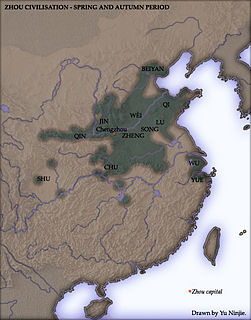 W
WThe Eastern Zhou was the second half of the Zhou dynasty of ancient China. It is divided into two periods: the Spring and Autumn and the Warring States.